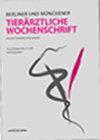管理局部皮肤药物不良反应(CADR)的挑战-一个病例报告
IF 0.6
4区 农林科学
Q4 VETERINARY SCIENCES
Berliner und Munchener tierarztliche Wochenschrift
Pub Date : 2020-01-01
DOI:10.2376/1439-0299-2020-14
引用次数: 0
摘要
本报告描述了一个罕见的病例,假定局部皮肤药物反应在一个10岁,雄性微型短毛腊肠犬皮下注射美洛昔康和马洛匹坦后。犬表现为肘关节跛行,皮下注射美洛昔康。随后三天出现带血腹泻和带血呕吐。在左胸壁反复皮下应用美洛昔康和马洛匹坦后,注射部位的皮肤和皮下硬化,并在大约面积上疼痛。8×8厘米。皮肤局部坏死,并在几天内划界。深层皮肤活检组织病理学显示严重的坏死性化脓性皮炎、血管炎和血管炎,伴有明显的水肿和深度隔离性血管坏死。血管周围嗜酸性粒细胞和血管血栓形成存在于环肌和皮肌的较深区域。微生物培养未发现细菌生长。根据治疗史、临床变化、组织病理学和缺乏相关鉴别诊断的实验室数据,局部皮肤药物不良反应(CADR)更受青睐。手术切除患处和开放性伤口处理成功,狗完全康复。这一罕见的犬局部CADR病例说明了精确病史的重要性,排除相关鉴别诊断的策略以及最终确定兽医学局部CADR的困难。本文章由计算机程序翻译,如有差异,请以英文原文为准。
Challenges in Managing Local Cutaneous Adverse Drug Reactions (CADR) – A Case Report
This report describes a rare case of a presumed local cutaneous drug reaction in a 10-year old, male miniature short-haired dachshund after subcutaneous injection of meloxicam and maropitant. The dog was presented with cubital joint lameness and meloxicam was injected subcutaneously. Bloody diarrhoea and bloody emesis developed over the next three days. After a repeated subcutaneous application of meloxicam and maropitant into the left thoracic wall, the skin and subcutis at the injection site indurated and became painful over an area of approx. 8x8 cm. The skin became locally necrotic and was demarcated within a few days. Histopathology of deep skin biopsies revealed severe, necrosuppurative dermatitis, panniculitis and vasculitis with marked edema and deep sequestrating pannicular necrosis. Perivascular eosinophils and vascular thrombosis were present in deeper areas of the panniculus and cutaneous muscle. Microbiological culturing failed to identify bacterial growth. Based on the treatment history, clinical changes, histopathology and the lack of laboratory data suggestive of relevant differential diagnoses, a local cutaneous adverse drug reaction (CADR) was favoured. Surgical removal of affected areas and an open wound management were successful and the dog fully recovered. This rare case of localized canine CADR illustrates the importance of a precise medical history, a strategie to exclude relevant differential diagnoses and the difficulties in ultimately confirming localized CADR in veterinary medicine.
求助全文
通过发布文献求助,成功后即可免费获取论文全文。
去求助
来源期刊
CiteScore
0.90
自引率
0.00%
发文量
0
审稿时长
18-36 weeks
期刊介绍:
The Berliner und Münchener Tierärztliche Wochenschrift is an open access, peer-reviewed journal that publishes contributions on all aspects of veterinary public health and its related subjects, such as epidemiology, bacteriology, virology, pathology, immunology, parasitology, and mycology. The journal publishes original research papers, review articles, case studies and short communications on farm animals, companion animals, equines, wild animals and laboratory animals. In addition, the editors regularly commission special issues on topics of major importance. The journal’s articles are published either in German or English and always include an abstract in the other language.

 求助内容:
求助内容: 应助结果提醒方式:
应助结果提醒方式:


